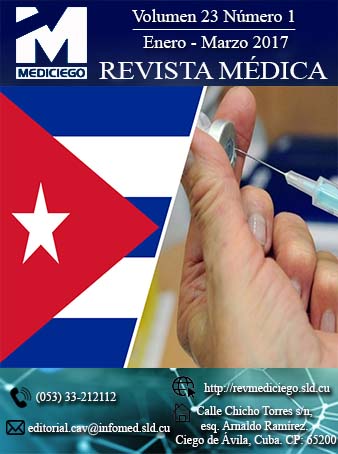Social value of the prevention of risk factors for malocclusion in the temporal dentition
Abstract
Introduction: among oral affections, malocclusion occupies the third place due to its prevalence and incidence in the population and it is a risk factor for periodontal diseases, caries and temporomandibular disorders; the aesthetic, functional and psychological alterations that malocclusion causes make it a public health problem, which reflects important social aspects, such as equity, health promotion and prevention, quality of care and ethical issues related to them.
Objective: to base the social value of preventive work on the risk factors for malocclusion in the temporal dentition.
Method: the national and international bibliography of the last five years, available in databases of Internet, in Spanish and English was reviewed; the most updated works were selected and, based on them, a structured synthesis of the topic was developed.
Development: temporary dentition is very vulnerable to cavities, especially to interproximal ones in temporal molars; on the other hand, the premature loss of the temporal teeth causes a decrease in the space reserved for the permanent successors, due to the migration of the adjacent teeth, which causes a shortening of the arch length and malocclusion.
Conclusions: sociocultural risk factors influence the development of malocclusions from an early age, for which is important to take into account the close relationship between the sociological, scientific and technological aspects of preventive work, in order to identify the risk factors of the entity from the stage of the temporary dentition.Downloads
Published
How to Cite
Issue
Section
License
Copyright (c) 2021 Dayamí López Martín, Raúl Cubero González, Yelec Estrada Guerra, Yadira Estrada Guerra, Kirenia Concepción López, Sady Machado Ramos

This work is licensed under a Creative Commons Attribution 4.0 International License.
Those authors who have publications with this journal accept the following terms of the License CC Attribution-NonCommercial 4.0 International (CC BY-NC 4.0):
You are free to:
- Share — copy and redistribute the material in any medium or format for any purpose, even commercially.
- Adapt — remix, transform, and build upon the material for any purpose, even commercially.
The licensor cannot revoke these freedoms as long as you follow the license terms.
Under the following terms:
- Attribution — You must give appropriate credit , provide a link to the license, and indicate if changes were made . You may do so in any reasonable manner, but not in any way that suggests the licensor endorses you or your use
- No additional restrictions — You may not apply legal terms or technological measures that legally restrict others from doing anything the license permits.
The journal is not responsible for the opinions and concepts expressed in the works, which are the exclusive responsibility of the authors. The Editor, with the assistance of the Editorial Committee, reserves the right to suggest or request advisable or necessary modifications. Original scientific works are accepted for publication, as are the results of research of interest that have not been published or sent to another journal for the same purpose.
The mention of trademarks of specific equipment, instruments or materials is for identification purposes, and there is no promotional commitment in relation to them, neither by the authors nor by the editor.






















